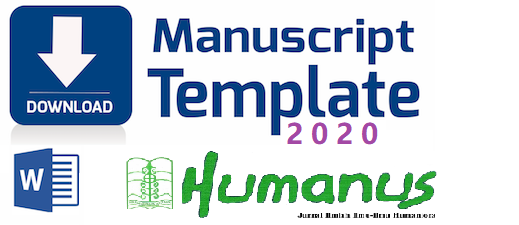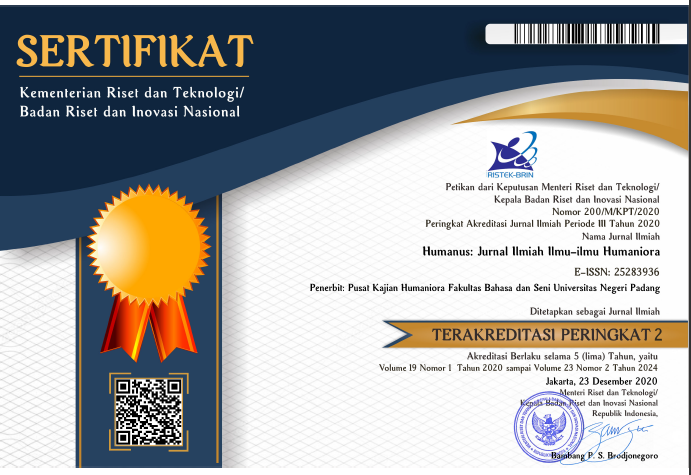The Meaning of the Word Makan in the Banjarese Language as a Treasure of Language Culture
 ), Eka Suryatin(2), Siti Jamzaroh(3),
), Eka Suryatin(2), Siti Jamzaroh(3), (1) Badan Riset dan Inovasi Nasional
(2) Badan Riset dan Inovasi Nasional
(3) Badan Riset dan Inovasi Nasional
 Corresponding Author
Corresponding Author
Copyright (c) 2023 Humanus
DOI : https://doi.org/10.24036/humanus.v22i1.119439
Full Text:
 Language : Indonesia
Language : Indonesia
Abstract
Keywords
References
Abidin, Z. (2021). Variasi Makna Kata ‘ Berjalan ’ dalam Bahasa Bonai Dialek Ulakpatian Meaning Variety of the Word ‘ Berjalan ’ ( Walking ) in Language Bonai Ulakpatian Dialect. 12(2). https://doi.org/DOI: https://doi.org/10.31503/madah.v12i2.422
Abu Bakar, K. T., Jalaluddin, N. H., & Mohamed Sultan, F. M. (2021). Sorotan Semula Tatabahasa Dewan. Issues in Language Studies, 10(2), 45–64. https://doi.org/10.33736/ils.3448.2021
Agwuele, A. (2021). “Exertion is not connected to success”: Everyday Yoruba discourse of work and success. Africa, 91(5), 810–831. https://doi.org/10.1017/S0001972021000590
Agyekum, K. (2019). The ethnopragmatics of akan advice. Pragmatics, 29(3), 309–331. https://doi.org/10.1075/prag.17002.agy
Alfisyah. (2019). Tradisi Makan Urang Banjar. Jurnal Pendidikan Sosiologi Antropologi, 1(3), 97–109. https://ppjp.ulm.ac.id/journals/index.php/padaringan/article/view/1408/1142
Américo, B. L., & Carniel, F. (2022). A rede estrangeira de estudos sobre antropologia da educação pensada por meio da inscrição literária. Educação e Pesquisa, 48, 1–19. https://doi.org/10.1590/s1678-4634202248234239
Arianto, T., & Simanjuntak, D. S. (2020). Representation of ecocriticism in the folklore of Mak Ungkai spirit. Studies in English Language and Education, 7(2), 576–591. https://doi.org/10.24815/siele.v7i2.16822
Athanasopoulos, P., & Bylund, E. (2021). Whorf in the wild: Naturalistic evidence from human interaction. Applied Linguistics, 41(6), 947–970. https://doi.org/10.1093/APPLIN/AMZ050
Beleq, D. D., Utara, L., Putro, A., Wicaksono, A., Nurcahyono, O. H., & Pranawa, S. (2020). Pemaliq : Myth as an Effort to Defend the Customs of Sasak in Desa Beleq Hamlet , Gumantar , North Lombok Pemaliq : Mitos Sebagai Sebuah Usaha Mempertahankan Adat Sasak. 243–253. https://doi.org/10.24036/humanus.v19i2.109877
Bringsøe, H., Suthanthangjai, M., Suthanthangjai, W., & Nimnuam, K. (2020). Eviscerated alive : Novel and macabre feeding strategy in Oligodon fasciolatus ( Günther , 1864 ) eating organs of Duttaphrynus melanostictus ( Schneider , 1799 ) in Thailand. 163, 157–163. https://doi.org/10.3897/herpetozoa.33.e57096
Dementyev, V. V. (2021). Heart-moving stories about kitties in Runet in the paradigm of the genres of volunteer discourse. Zanry Reci, 32(4), 305–326. https://doi.org/10.18500/2311-0740-2021-4-32-305-326
Fadhilah, N., Rais, W. A., & Purnanto, D. (2019). Madurese Proverbs Using Color Name Element: an Ethnolinguistic Study. Humanus, 18(2), 224. https://doi.org/10.24036/humanus.v18i2.107167
Godioli, A., & Pedrazzini, A. (2019). Falling stars and sinking ships: Framing and metaphor in cartoons about Brexit. Journal of European Studies, 49(3–4), 302–323. https://doi.org/10.1177/0047244119859167
Hanafi, N. (2020). Refleksi Budaya Lampau Leksikon Kebendaan Peribahasa Banjar: Kajian Etnolinguistik. UNDAS: Jurnal Hasil Penelitian Bahasa Dan Sastra, 16(1), 93. https://doi.org/10.26499/und.v16i1.2176
Hauksson-Tresch, N. (2021). Visual Rhetoric of the Truth in the Dreyfus Affair: A Semiotic Approach. International Journal for the Semiotics of Law, 34(1), 127–143. https://doi.org/10.1007/s11196-019-09617-4
Intan, T. (2018). Fenomena Tabu Makanan pada Perempuan Indonesia dalam Perspektif Antropologi Feminis. PALASTREN Jurnal Studi Gender, 11(2), 233. https://doi.org/10.21043/palastren.v11i2.3757
Ivanovic, I. (2017). Comparative study of metaphor in british and United States of america (Us) political discourse. XLinguae, 10(2), 16–29. https://doi.org/10.18355/XL.2017.10.02.02
Jamzaroh, S. (2019). the Language Attitude of Culinary Entrepreneurs in Banjarmasin. Humanus, 18(2), 208. https://doi.org/10.24036/humanus.v18i2.107171
Karim, S. A. (2022). Personal Naming System of Bima Tribe in West Nusa Tenggara : Usage and Naming Behaviour. 15(1), 20–41. https://doi.org/10.18326/rgt.v15i1.20-41
Karmina, S., Dyson, B., Watson, P. W. S. J., & Philpot, R. (2021). Teacher implementation of cooperative learning in indonesia: A multiple case study. Education Sciences, 11(5). https://doi.org/10.3390/educsci11050218
Hapip, A(2008) . Kamus Banjar Indonesia. Banjarmasin: CV. Rahmad Hafiz Al Mubaraq
Tim. (2018). Kamus Besar Bahasa Indonesia. Badan Pengembangan dan Pembinaan Bahasa, Kementerian Pendidikan dan Kebudayaan. Jakarta: Balai Pustaka.
Kim, D. (2020). Learning Language, Learning Culture: Teaching Language to the Whole Student. ECNU Review of Education, 3(3), 519–541. https://doi.org/10.1177/2096531120936693
Kuhn, A. F. (2021). An Animal Counter-Textuality? Sounding the Dog in the Global South. Word and Text, XI, 135–146. https://doi.org/10.51865/JLSL.2021.09
Kurnia, P. D. A., & Bram, B. (2021). Translation Procedures of Culture-Specific Terms in Indonesian Poems in on Foreign Shores. Linguistik Indonesia, 39(2), 181–203. http://www.ojs.linguistik-indonesia.org/index.php/linguistik_indonesia/article/view/255
Lomas, T. (2019). The elements of eco-connection: A cross-cultural lexical enquiry. International Journal of Environmental Research and Public Health, 16(24). https://doi.org/10.3390/ijerph16245120
Manaf, N. A. (2015). Dinamika Penggunaan Kata Dan Istilah Dalam Karya Sastra Indonesia Dan Implikaturnya. Humanus, xiv(1), 92–100. https://doi.org/DOI: 10.24036/jh.v14i1.5406
Mazur, A., Obroślak, R., Nieścioruk, K., Król, Z., Gabryszuk, J., & Rybicki, R. (2016). Analysis of erosion control constructions effectiveness. The case of a road gully in Wielkopole (Lublin Upland). Journal of Ecological Engineering, 17(4), 180–183. https://doi.org/10.12911/22998993/64507
Moehardini, D. P., Haristiani, N., & Sutedi, D. (2017). Kajian Semantik Kanyouku yang Menggunakan Kata “Koe” (声). Edujapan, 1(2), 185–197. https://ejournal.upi.edu/index.php/edujapan/issue/view/881
Muryasov, R. Z., Samigullina, A. S., & Bakiev, A. G. (2018). Metaphor through the lens of linguosynergetics (Exemplified by the concept “DEATH” in terry Pratchett’s discourse). XLinguae, 11(3), 136–145. https://doi.org/10.18355/XL.2018.11.03.13
Mugeni, dkk. (2008). Kamus Bahasa Indonesia-Banjar Dialek Kuala. Banjarbaru.Balai Bahasa Banjarmasin.
Musdaliph, dkk. (2008). Kamus Bahasa Banjar Dialek Hulu-Indonesia. Banjarbaru.Balai Bahasa Banjarmasin.
Noor, W. K., & Qomariyah, U. (2019). Jurnal Sastra Indonesia Impian. 8(2), 103–110. http://journal.unnes.ac.id/sju/index.php/jsi
Nursida, I. (2014). Perubahan makna Sebab dan bentuknya: sebuah kajian historis. Al-Faz, 2(2), 46–61. https://media.neliti.com/media/publications/publications/233702-perubahan-makna-sebab-dan-bentuknya-sebu-01b5ef30.pdf
Odyntsova, H., & Kondratieva, T. (2022). Aphorisms As Means of Interpreting of Linguistic Terms: Peculiarities of Defining. Folia Linguistica et Litteraria, XIII(39), 187–205. https://doi.org/10.31902/fll.39.2022.10
Okeke, G. T., & Okeke, C. O. (2022). On the semantic-pragmatic interface of Igbo verbs of perception. Cogent Arts and Humanities, 9(1). https://doi.org/10.1080/23311983.2022.2025991
Ortega, G., & Özyürek, A. (2020). Systematic mappings between semantic categories and types of iconic representations in the manual modality: A normed database of silent gesture. Behavior Research Methods, 52(1), 51–67. https://doi.org/10.3758/s13428-019-01204-6
Parmentier, F. B. R., Pacheco-Unguetti, A. P., & Valero, S. (2018). Food words distract the hungry: Evidence of involuntary semantic processing of task-irrelevant but biologically-relevant unexpected auditory words. PLoS ONE, 13(1), 1–17. https://doi.org/10.1371/journal.pone.0190644
Previtali, M., Brumana, R., Stanga, C., & Banfi, F. (2020). An ontology-based representation of vaulted system for HBIM. Applied Sciences (Switzerland), 10(4). https://doi.org/10.3390/app10041377
Pujiastuti, S. (2021). Leksikon-leksikon Bermakna ‘ Makan ’ dalam Bahasa Jawa Dialek Banyumas. 16(2), 122–135. doi: 10.14710/nusa.16.2.122-135
Pulido, M. F., & Dussias, P. E. (2019). The neural correlates of conflict detection and resolution during multiword lexical selection: Evidence from bilinguals and monolinguals. Brain Sciences, 9(5). https://doi.org/10.3390/brainsci9050110
Rustanti, N. (2018). Makna Kata Makan Dan Kakeru Sebagai Polisemi ( Kajian Linguistik Kognitif ). Jurnal TEXTURA, 5(4), 56–65. https://journal.piksi.ac.id/index.php/TEXTURA/issue/view/18
Setiawan, F. X. R. (2016). Makan sebagai Aktivitas Produktif: Tinjauan Filosofis tentang Makan dari Perspektif Foucaultian. Melintas, 31(3), 303. https://doi.org/10.26593/mel.v31i3.1920.303-335
Short, W. M. (2021). Can Figures Persuade? Zeugma As a Figure of Persuasion in Latin. Classical Quarterly, 71(2), 632–648. https://doi.org/10.1017/S0009838821000859
Singh, C. (2021). Science in the vernacular? Translation, terminology and lexicography in the Hindi Scientific Glossary (1906). South Asian History and Culture, 13(1), 63–86. https://doi.org/10.1080/19472498.2021.2001200
Sulistyono, Y., & Fernandez, I. Y. (2019). Linguistic situation around east flores and Alor-Pantar islands in east Indonesia. Humanities and Social Sciences Reviews, 7(3), 189–194. https://doi.org/10.18510/hssr.2019.7329
Supatra, H. (2012). Pengikisan Bahasa Dalam Masyarakat Jawa. Sabda, 10(2). https://doi.org/https://doi.org/10.14710/sabda.10.2.%25p
Suryadi, M. (2019). Potret Aktivitas Makan dalam Leksikon Jawa dan Nilai Filosofi. Nusa: Jurnal Ilmu Bahasa Dan Sastra, 14(3), 272. https://doi.org/10.14710/nusa.14.3.272-282
Wantini, Sutrisno, Casmini, & Suyatno. (2019). Therapy of social-emotional development on autism spectrum disorder diagnosed child in inclusive early childhood education and development Yogyakarta, Indonesia. In International Journal of Learning, Teaching and Educational Research (Vol. 18, Issue 7, pp. 33–50). https://doi.org/10.26803/ijlter.18.7.3
Wimrayardi, Putra, I. E. D., Hidayat, H. A., & Parmadi, B. (2021). Local Culture As Tourism Attraction of Payakumbuh City. Humanus: Jurnal Ilmiah Ilmu Ilmu Humaniora, 20(1), 111–123. https://doi.org/10.24036/humanus.v20i1.112562
Yasin, B., Yusuf, Y. Q., & Junita, M. (2018). Acehnese teachers teaching English to Rohingya refugees: Process and cultural barriers. SAGE Open, 8(2), 1–14. https://doi.org/10.1177/2158244018782574
 Article Metrics
Article Metrics
 Abstract Views : 263 times
Abstract Views : 263 times
 PDF Downloaded : 125 times
PDF Downloaded : 125 times
Refbacks
- There are currently no refbacks.
Copyright (c) 2023 Humanus

This work is licensed under a Creative Commons Attribution-NonCommercial 4.0 International License.











